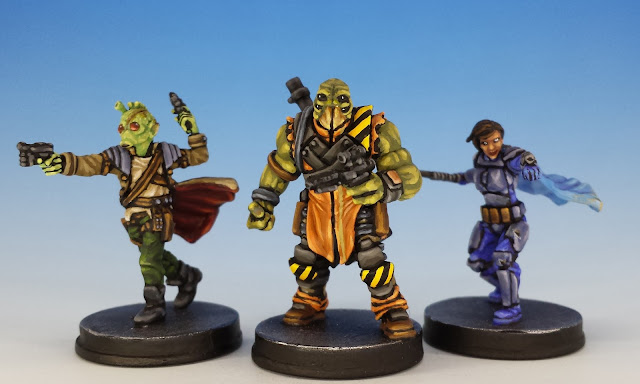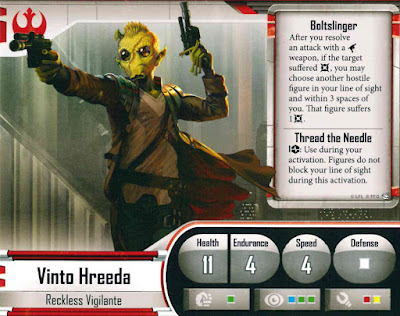Terror of the Lichemaster. Part 10
Cut is the branch that might have grown full straight,
And burned is Apollo's laurel bough,
That sometime grew within this learned man...
Whose fiendful fortune may exhort the wise
Only to wonder at unlawful things,
Whose deepness doth entice such forward wits,
To practise more than heavenly power permits.
(Dr. Faustus, Christopher Marlowe, Act 5, Scene 3)
Welcome to the finale in my series on The Terror of the Lichemaster, the classic campaign published in 1985 for Warhammer 2nd edition. To assist other hobbyists, I've created a permanent gallery of all my painted miniatures for Terror and, like my other galleries (hello Talisman!), you can find it on the menu on the right.
I have not yet played through the campaign. Will the Lichemaster's Faustian bargain lead to his downfall? Or will he consume Frugelhofen with magic and malice? To finish things off this series of ten posts, I thought I'd share some ideas on how to run the three battles that compose the campaign and decide Kemler's fate.
The first order of business is to point out that the maps in the Lichemaster campaign book are defective. As beautiful as they are (thanks to Dave Andrews), they are supposed to indicate where the undead and humans are to be deployed in each battle, and they fail to do so. This problem was recognized back in 1987. In a flyer entitled "Terror of the Glichmaster" Games Workshop helpfully provided amended maps. I reproduce them here:
Incidentally, this same flyer lists the original price of the entire suite of miniatures for the Lichemaster. This is not just the 18 central characters (which are pictured in the original advert), but also the 105 rank-and-file miniatures necessary to play through the whole campaign: 40 skeletons, 20 zombies, 20 militiamen, 20 archers and 5 dwarves. That's 123 metal miniatures in total. Guess how much! Go ahead, guess...
 |
| "I will bankrupt you." |
It was 50 GBP (in 1987 currency) for all 123 minis, equal in today's currency to about 132 GBP or $165 USD. When I saw that, I nearly choked but instead I perished of heart failure. Gimbrin Finehelm alone cost me quite a bit more than that. Sigh... I guess that's the way of all collectibles. They start out as junk and time alchemizes them into gold.
Well, back to the game! One of the core principles of the Oldhammer movement is a relaxed approach to game balance. As Zhu wrote in the Oldhammer Contract, "As the Spartans will tell you, warfare has never been about perfectly matched armies squaring off at each other, and fantasy warfare even less so." You can see this axiom in the Lichemaster scenario itself, where it's never clear who is really the underdog, and there's certainly not mention of the point values of each force.
But because I am a curious little monkey, I calculated the rough point value for each side. In fact, in a fit of mania, I calculated the points in both 2nd edition Warhammer (which was the original rules set for the Lichemaster) and 3rd edition (which represents a more accurate refinement of the system of points values).* It's a rough estimate since some characters (like Gimbrin or Kemler) have idiosyncratic stats, and because characters from 2nd edition don't line up perfectly characters from 3rd editions. With those caveats, here are the results:
Battle 1 - Assault on the Mine
Dwarf Hero + 5 Dwarves = 135 points (2nd ed.) or 148 points (3rd ed.)
versus
Undead Champion + 20 Skeletons = 81 points (2nd ed.) or 294 points (3rd ed.)
Battle 2 - The Attack on Bogels' Farm
2 Human Heroes + 1 Halfling Hero + 3 Humans + 1 Crazy Dog = 83.5 points (2nd ed.) or 139 points (3rd ed.)
versus
Undead Champion + 10 Zombies = 19 points (2nd ed.) or 74 points (3rd ed.)
Battle 3 - The Defence of Frugelhofen
3 Human Heroes + 1 Elf Hero + 1 Halfling + 40 soldiers + 4 magic items = 810 points (2nd ed.) or 862 points (3rd ed.)
versus
Heinrich Kemler + Undead Hero + 20 Skeletons + 10 Zombies + 3 magic items = 1227.5 points (2nd ed.) or 793 (3rd ed.)
What conclusions can we draw from these sums? It seems to me that the first 2 scenarios favour the humans/dwarves in a toe-to-toe fight, whereas the final battle is more evenly matched. But in all these scenarios, the forces of good will rout if they fail a single fear test or get pushed back in battle (since skeletons & zombies, of course, cause fear). This vulnerability to fear is especially pronounced in the first 2 battles, where the forces of good are so few in number. Thus these two battles will most likely hinge on just a couple of dice rolls.
The fact that these battles might come down to a few fear rolls brings me to my last point. As much as I love Warhammer Fantasy Battle, I'm not sure it's the ideal rules set to bring to life The Terror of the Lichemaster. The first two scenarios are on a much too small scale, involving only 5 or 7 models for the forces of good. (In my view, this reflects the fact that in the early days, Games Workshop branded WFB as half role playing game and half war game). Even the last set piece battle seems a little awkward for WFB since each side is unlikely to have more than 2 or 3 massed units, and that doesn't leave much room for strategy or maneuver. And finally, as I already mentioned, the rules for fear in WFB are so unforgiving that it might mean that the battles end before one side can even complete a charge action. It seems a shame that a scenario that takes years to collect and months to paint might be over in a few minutes.
 So what are the alternatives. Whiskey Priest and Warlord Paul once made the excellent point that Mordheim (aka Warhammer Skirmish from the 6th edition of the rules) would be a better way to implement small-scale scenarios like the first two battles in Terror of the Lichemaster. This option requires little modification from the existing rules, and allows the players an easy transition from using skirmish rules for the first two battles and then slugging out a traditional, full-scale Warhammer Fantasy Battle for the finale.
So what are the alternatives. Whiskey Priest and Warlord Paul once made the excellent point that Mordheim (aka Warhammer Skirmish from the 6th edition of the rules) would be a better way to implement small-scale scenarios like the first two battles in Terror of the Lichemaster. This option requires little modification from the existing rules, and allows the players an easy transition from using skirmish rules for the first two battles and then slugging out a traditional, full-scale Warhammer Fantasy Battle for the finale.
I think Saga is another strong contender. Although traditionally a historical wargame, Saga boasts a special expansion for an undead faction ("The Revenants") led by a necromancer who bears a striking resemblance to Heinrich Kemler. (All the minis for this expansion are sculpted by Citadel alumnus Bob Naismith). In scale Saga is perfect, especially for the first two battles of Terror. And Saga's unique rules would allow for a dramatic, story-driven battle. By using Saga instead of Warhammer, the undead lose the game-ending power of fear, but gain the power of re-animating the fallen as they die on the battlefield.
Finally, another option is Otherworld Miniature's Fantasy Skirmish Rules. I'm a big fan of this rulebook (some of the artwork in the book was devised by Oldhammer stalwart Zhu Bajiee). By using this system, the players would be allowed a broad scope to customize and personalize each of the personalities in the campaign. It would take a lot of time to reconfigure Terror of the Lichemaster for Otherworld, but I think the effort would be repaid with rich dividends.
Now I have to turn my mind to which system to use... I will keep you all posted on my progress and I hope to have a battle report in a few months. Thanks for sharing this journey, to wonder at Heinrich Kemler's unlawful things...

* For rules-junkies like myself, I will add a few observations about Warhammer points systems. When applying the 3rd edition point system, I've included the gloss contained in Warhammer Armies (1988) that equipment costs are not multiplied if the base figure is 10 points or more. Even with that gloss, it's interesting that the points calculation from 2nd edition to 3rd edition doesn't change much when examined from a macro scale, except that skeletons and zombies are cheap in 2nd edition and become more expensive in 3rd edition (much more expensive for skeletons, leaping by 2.5 points for a base model to 10 points). Also, magic users and magic items are very expensive in 2nd edition and become cheaper in the 3rd editions (which is why Kemler's force is worth less points in the 3rd edition, even though his skeleton guard leaped in price).





















